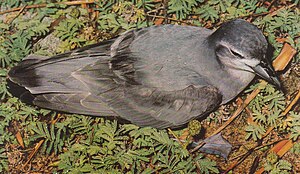Belcher Petrel
| Belcher Petrel | ||||||||||
|---|---|---|---|---|---|---|---|---|---|---|

Belcher petrel ( Pachyptila belcheri ) |
||||||||||
| Systematics | ||||||||||
|
||||||||||
| Scientific name | ||||||||||
| Pachyptila belcheri | ||||||||||
| ( Mathews , 1912) |
The Belcher petrel ( Pachyptila belcheri ), also known as the thin-billed petrel , is a monotypical species from the petrel family. The IUCN classifies the species as non-endangered ( least concern ) because the distribution area is very large and the population appears stable. The world population is estimated to be at least 7 million sexually mature individuals.
Appearance
The Belcher petrel reaches a body length of 25 to 26 centimeters. The wing length is 16.6 to 19.1 centimeters and the wingspan is 56 centimeters. The weight is between 115 and 180 grams. Males tend to be slightly larger than the females. The biggest difference is in the beak length.
The top of the body is blue-gray with a narrow dark band on the tail. A darker "M" runs across the wings, but it is less developed than is the case with other whale birds . The white of the face extends over the eyes. A dark eye stripe runs down to the nape of the neck. The underside of the body is white. The sides of the chest are pale light gray. There is a possibility of confusion with all whale bird species.
distribution
The Belcher petrel breeds in the Falkland Islands , Kerguelen , Crozet Islands, and possibly also on South Georgia . In 1984 a large breeding colony was discovered on Isla Noir off the coast of southern Chile. Outside of the breeding season, the Belcher petrel occurs as far as Java, Western Australia, Western Peru, Southern Brazil and South Africa.
Way of life
The Belcher petrel mainly eats crustaceans, cephalopods and small fish. It is usually observed in schools on the high seas. He is also regularly associated with the pigeon petrel.
The Belcher petrel breeds in self-dug earthworks. These have a length between 60 centimeters and 3.5 meters. On the Falkland Islands, the burrows are 15 to 190 meters above sea level. The actual nest hollow is laid out with grass and feathers. In the Falkland Islands, adult Belcher petrels return to breeding colonies in September. The actual breeding season begins in November when the Belcher petrels lay. The clutch consists of a white-shelled egg. The breeding season is 46 to 47 days. The young birds can fledge between 49 and 50 days of age. During the breeding season, breeding birds of the Falkland Islands find their food on the continental shelves east and south of the Falkland Islands. Both parent birds are equally involved in the breeding and rearing of the young birds. They only raise one clutch per year.
On the Kerguelen, the Belcher petrel seems to be competing with blue petrels for nesting sites .
supporting documents
literature
- Hadoram Shirihai: A Complete Guide to Antarctic Wildlife - The Birds and Marine Mammals of the Antarctic Continent and Southern Ocean , Alula Press, Degerby 2002, ISBN 951-98947-0-5 .
- Robin and Anne Woods: Atlas of Breeding Birds of the Falkland Islands , Anthony Nelson, Shorpshire 1997, ISBN 0904614-60-3 .
Single receipts
- ↑ BirdLife Factsheet for the Belcher Petrel , accessed December 12, 2010
- ^ Shirihai, p. 178
- ^ Shirihai, p. 178
- ^ Wood, p. 47
Web links
- Pachyptila belcheri inthe IUCN Red List of Threatened Species 2012.2. Listed by: BirdLife International, 2012. Retrieved November 17, 2012.
